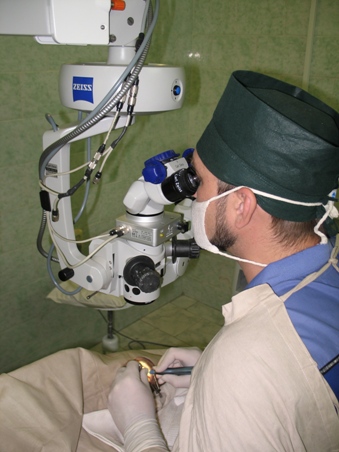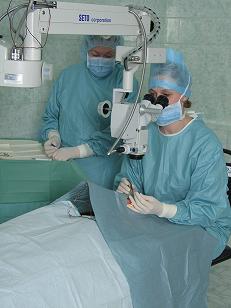Surgical unit is composed of three operating rooms having 5 surgical tables.
Surgical unit and anesthetic service are provided with the most perfect:
- Microscopes of MOLLER-WEDEL,CARL ZEISS OPMI VISU 210, TAKAGI, SETO manufacturers;
- Microsurgical systems: "MILLENIUM", "OPTIKON", NIDEK;
- Anesthesio- breathing apparatuses: "STEPHON-ARTEC",BLEASE FOCUS
- Cardiomonitoring devices: "PHILIPS M3046A", "TRITON", "ÎÏ 31.1",SHILLER
Surgical unit is equipped with automatic ventilation and air-conditioning system.
In the surgical unit operative interventions on account of the following ophthalmic pathologies are performed:
- cornea diseases;
- crystalline lens diseases, including surgery using PEC techniques and IOL implantation;
- traumas;
- retinal diseases;
- myopia;
- appendage of eye diseases;
- neoplasms;
- strabismus;
- ptosis, operations on eyelids;
- glaucoma( including with adrenaline);
- cornea transplantation;
- pathology vitreoretinalis ( including vitreoectomy with lasercoagulation and silicone fluid tamponade);
- operations on account of eye traumas and foreign bodies inside eyes;;
- pterygism.
|
 |
The age of the patients operated – from 7 days to 90 years and more.Before
the operation every patient is examined by an anesthetist to select the type
of anesthesia individually with an allowance for their condition and the type
of operation in prospect. If it is necessary, patients may be consulted by
a therapeutist and neurologist in conference.
Ànesthesiologists give various types of anesthesia depending on complicacy
and how traumaticthe operation planned is going to be:
- local [topical] anesthesia,
- conduction anesthesia,
- block pterypistillate ganglion,
- vagosympathetic blockade,
- mechanical/bag-mask ventilation,
- intravenous anesthesia,
- endotracheal anesthetic,
- neuroleptanalgesia,
- total intravenous anesthesia,
- controlled hypotension.
During the course of operation the necessary homeostasis correction is carried
out in concomitant diseases,
for instance diabetes mellitus, arrhythmia,
bronchial [spasmodic] asthma. Constant monitoring of the patient is also conducted.
|
 |
In the department and operative unit emergency state therapy is performed too.
In case of need anesthesiologists consult the patients before admitting them
into the hospital.
Paid services available:
- In-patient treatment of profile patients having no insurance policies.
- Consultative reception of out-patients.
- All above-listed diagnostic techniques and manipulations.
- Ambulatory surgical treatment.
- Allocation of beds for the gravely sick patients’ relatives (by arrangement) or
a ward (if there are any available). The relatives must have results of the chest fluorography on them.
Information renewal date 12.04.2010
|